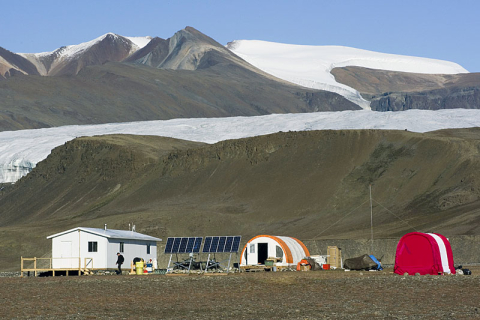Deglaciated Soils: Microorganisms emerging from melting glaciers

Growing up in Minnesota, McGill PhD student Scott Sugden spent a lot of time outdoors, particularly canoeing and backpacking in the Arctic.
The Arctic became a landscape that he cared deeply about. It led to work in outdoor education, a high school biology classroom, and now as a researcher in environmental microbiology.
This perfect blend of the outdoors and science brought him to Lyle Whyte’s laboratory in McGill's Department of Natural Resources. Professor Whyte has spent more than two decades conducting polar microbiology research at McGill and shares a passion for the outdoors.
Sugden, a third-year PhD student, approached Whyte about pursuing research looking at deglaciated soils near the North and South Poles. Deglaciated soils are soils that have been trapped under glaciers for thousands of years, with very limited biological activity during that time. As a result of climate change, these nutrient-poor soils, or “pioneer soils,” are now exposed, and new communities of microorganisms have subsequently emerged and are evolving.
With glacial ice covering 10 percent of Earth’s land area and global temperatures rising, researchers have already predicted that more than one-third of this land area will be exposed by 2100, making deglaciated soils an important area of study.
Through a project award from EMSL, the Environmental Molecular Sciences Laboratory, a United States Department of Energy Office of Science user facility, Sugden and Whyte are developing a long-term, predictive understanding of how microbial activity affects carbon flows and climate patterns in the Arctic—one of the most rapidly changing environments on the planet.
In 2022 and 2023, Sugden’s field research took him to receding glaciers near both poles. He traveled by prop plane to White Glacier, located near the McGill Arctic Research Station on Axel Heiberg Island in Nunavut, Canada. To get to the Hurd Glacier on Livingston Island in Antarctica, Sugden flew to Chile, boarded a charter flight to Antarctica, and then took a boat to the island.
In both locations, Sugden collected samples of five- to sixty-year-old soils from the area in front of the glaciers.
“We’re collecting soils of a bunch of different exposure ages to look at this process of community development and, in particular, how microbial community development affects the flow of nutrients through that system, especially carbon,” said Sugden. “That’s of major interest for the climate. Soil can be a really important carbon repository, but it can also be a really important carbon source, so it’s important for predicting future Arctic climate budgets and carbon budgets.”